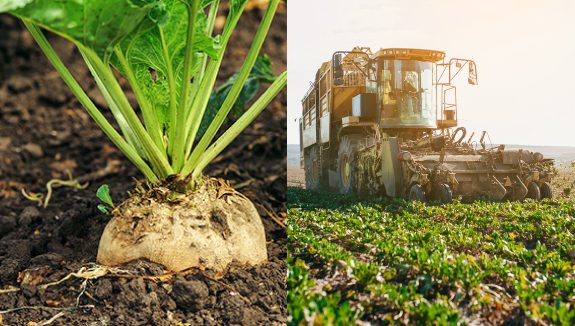Sugar beet vs sugar cane: Which crop is more eco-efficient?
All You Need to Know Regarding Sugar Beet Vs Sugar Cane: Insights Into Their Functions in the Cane Sugar Sector
The sugar industry relies heavily on both sugar beet and sugar cane, each offering distinct benefits and challenges. Comprehending their farming techniques, geographical circulation, and dietary influences discloses substantial distinctions. As customer choices change, the market deals with pushing demands for sustainability and development. Discovering these elements can provide much deeper insights into the future of sweeteners and their duties in the worldwide market. What advancements lie in advance for these crucial plants?
Review of Sugar Beet and Sugar Cane
Sugar beet and sugar cane are 2 main sources of sucrose, each with unique features and growing methods. Sugar beet, an origin vegetable, grows in warm climates and is typically grown in regions with cooler temperatures. It has a high sugar web content, normally about 16 to 20 percent, which is removed via a process of cutting and diffusion. In contrast, sugar cane is a tropical yard that thrives in cozy, humid environments. Its stalks can have 10 to 15 percent sucrose, and the removal process usually involves crushing the stalks to launch the juice.Both plants play considerable roles in the worldwide sugar sector, with sugar beet generally cultivated in Europe and The United States And Canada, while sugar cane is mainly expanded in countries like Brazil, India, and China. Sugar beet vs sugar cane. This geographical circulation mirrors the different climatic demands and farming practices fit to every plant, influencing their corresponding payments to sugar production worldwide
Cultivation Techniques and Expanding Problems
The cultivation methods and growing problems for sugar beetroots and sugar cane differ substantially due to their distinct soil and climate demands. Sugar beetroots grow in cooler environments with well-drained, fertile soils, while sugar cane likes warmer temperature levels and can endure poorer dirts. On top of that, the harvesting techniques for both crops differ, showing their special expanding techniques and ecological adaptations.
Dirt Needs Contrast
While both sugar beet and sugar cane are important sources of sugar, their soil requirements reflect distinct preferences that influence cultivation techniques and expanding problems. Sugar beetroots prosper in well-drained, loamy soils rich in raw material, with a pH series of 6.0 to 8.0. This kind of dirt sustains their deep taproots, enabling vitamins and mineral absorption. Alternatively, sugar cane favors abundant, sandy loam or clay dirts that maintain wetness, ideally with a pH between 6.0 and 7.5. The origin system of sugar cane is extra extensive, needing dirt that can support its growth in an extra water-retentive setting. These varying soil demands require tailored agricultural techniques to optimize returns for each and every plant, stressing the value of dirt administration in their cultivation.
Climate Adaptability Distinctions

Collecting Methods Summary
Harvesting strategies for sugar beet and sugar cane vary considerably because of their unique cultivation approaches and growing conditions. Sugar beet is typically collected mechanically utilizing specialized devices that uproots the plants and divides the roots from the foliage. This process is normally conducted in cooler months to avoid wasting. In contrast, sugar cane harvesting usually includes manual work or mechanical cutters, where stalks are cut short. This technique is done during the completely dry season to decrease the moisture web content, which can affect sugar return. Additionally, the timing of the harvest is important, as both crops require to be harvested when they reach peak sugar concentration for reliable processing.
Geographical Circulation and Production Data
Both sugar beet and sugar cane offer as essential sources of sucrose, their geographical circulation Sugar beet vs sugar cane and production data expose remarkable differences. Sugar cane mostly prospers in tropical and subtropical climates, with significant manufacturing areas consisting of Brazil, India, China, and Thailand. On the other hand, sugar beet is primarily cultivated in pleasant regions, with leading manufacturers located in Europe, the United States, and Russia.According to current data, international sugar cane production greatly goes beyond that of sugar beet. In 2021, sugar cane represented around 79% of overall sugar manufacturing worldwide, while sugar beet added around 21%. Brazil stays the world's biggest sugar manufacturer, generally from sugar cane, producing over 38 million metric loads yearly. The United States is one of the top sugar beet producers, generating concerning 5 million metric loads each year. These statistics emphasize the essential role each crop plays in the global sugar industry

Nutritional Distinctions and Health Impacts
The nutritional composition of sugar beet and sugar cane differs considerably, influencing their particular health and wellness impacts. Sugar beet tends to have greater levels of certain vitamins and minerals, while sugar cane offers a various set of nutrients. Understanding these distinctions is important for evaluating their results on wellness and dietary choices.
Nutrient Make-up Contrast
When comparing the nutrient make-up of sugar beet and sugar cane, substantial differences emerge that can affect wellness results. Sugar beets are recognized to give a higher focus of necessary nutrients, including vitamins B6 and C, potassium, and magnesium. On the other hand, sugar cane has a tendency to have lower degrees of these nutrients, mainly acting as a carb source. Sugar beetroots also have dietary fiber, which is beneficial for digestive system health and wellness, while sugar cane lacks this part. Furthermore, the visibility of antioxidants in sugar beetroots contributes to potential health advantages, unlike sugar cane, which is mostly composed of sucrose. These distinctions highlight the differing nutritional accounts of both resources, which could influence customer choices and nutritional considerations.

Wellness Impacts Review
While both sugar beet and sugar cane are commonly made use of for sugar production, their unique dietary profiles cause differing health impacts. Sugar beet typically has higher levels of vitamins and minerals, such as potassium and magnesium, contributing to better overall nutritional worth. Alternatively, sugar cane's juice is abundant in anti-oxidants, which might supply additional health benefits.However, both sources mainly produce sucrose, which, when eaten over, postures risks such as obesity, diabetic issues, and heart problem. The glycemic index of sugar cane is often somewhat reduced than that of sugar beet, possibly making it a far better option for blood glucose monitoring. Eventually, moderation is crucial for both types to reduce negative wellness influences related to high sugar intake.
Environmental Factors To Consider in Sugar Production
Sugar production from both sugar beet and sugar cane offers financial advantages, it also elevates considerable environmental problems. The growing of these crops often entails substantial land use, which can bring about habitat destruction and loss of biodiversity. Furthermore, making use of plant foods and pesticides in sugar farming adds to soil destruction and water pollution, influencing local ecosystems.The high water intake required for watering, particularly in sugar cane manufacturing, intensifies water deficiency issues in some areas. Furthermore, logging for broadening sugar cane vineyards has been connected to boosted greenhouse gas discharges, further adding to climate change.Sustainable farming practices, such as plant turning and natural farming, are crucial to reduce these ecological effects. Sector stakeholders are increasingly acknowledging the requirement for liable farming techniques to assure the lasting viability of sugar production while reducing damage to the earth.
Economic Value in the Global Market
The environmental obstacles linked with sugar manufacturing underscore the need to examine its economic significance in see post the worldwide market. Sugar beet and sugar cane are essential to the farming economic situation, adding substantially to the livelihoods of millions directory worldwide. In 2022, the global sugar market was valued at approximately $50 billion, with sugar cane accounting for most of production. Nations such as Brazil, India, and China are leading manufacturers, influencing global supply chains and pricing structures. The competitors in between sugar beet and sugar cane likewise affects local economic climates, as farmers select crops based on market needs and weather conditions. Furthermore, the sugar industry supports secondary fields, consisting of food processing and biofuel production, boosting its general economic impact. As customer preferences shift in the direction of much healthier choices, the economic dynamics of sugar manufacturing might advance, necessitating ongoing analysis of its market significance in a transforming international landscape.
Future Fads and Innovations in Sugar Production
As the global need for sugar proceeds to evolve, advancements in sugar manufacturing are arising to address sustainability and performance obstacles. One remarkable fad is the raised fostering of accuracy agriculture innovations, which enable farmers to optimize yields while minimizing ecological influences. Additionally, advancements in reproducing strategies, such as CRISPR gene modifying, are being explored to develop sugar plants with improved resistance to insects and diseases, therefore lowering the demand for chemical inputs.Moreover, the combination of renewable resource resources in sugar processing plants is gaining grip, assisting to lower carbon impacts. The trend in the direction of bioprocessing is also considerable, as business want to transform by-products into value-added products like biofuels and bioplastics. Consumer preferences are moving in the direction of all-natural sweeteners, prompting research study right into different sources like stevia and monk fruit, which may reshape the landscape of the sugar market in the coming years.
Regularly Asked Inquiries
How Do Sugar Beet and Sugar Cane Taste In A Different Way?
Sugar beet and sugar cane show distinctive taste accounts. Sugar beet often tends to have a slightly natural sweet taste, while sugar cane offers a more robust, syrupy sweetness, contributing to their unique culinary applications and choices amongst customers.
Can Sugar Beet and Sugar Cane Be Made Use Of Reciprocally in Recipes?
Sugar beet and sugar cane can be utilized reciprocally in recipes, though their flavors and sweetness levels might differ slightly. Modifications might be needed to attain the desired taste and texture in cooking applications.
What Are the Byproducts of Sugar Beet and Sugar Cane Handling?
The spin-offs of sugar beet and sugar cane processing include molasses, bagasse, and pulp (Sugar beet vs sugar cane). These products are made use of in pet feed, biofuel production, and various industrial applications, boosting sustainability and lowering waste in the sugar sector
Are There Any Alternative Makes Use Of for Sugar Beet Besides Sugar Production?
The alternate uses for sugar beet expand beyond sugar production. They include animals feed, biofuel production, and the extraction of plant-based chemicals, showcasing sugar beet's adaptability within farming and commercial applications.
Just How Does Environment Modification Affect Sugar Beet and Sugar Cane Crops?
Climate modification impacts sugar beet and sugar cane plants by changing temperature level and rainfall patterns. Raised heat stress, drought, and shifting pest populations can reduce returns, testing farmers to adapt their techniques for sustainable manufacturing.